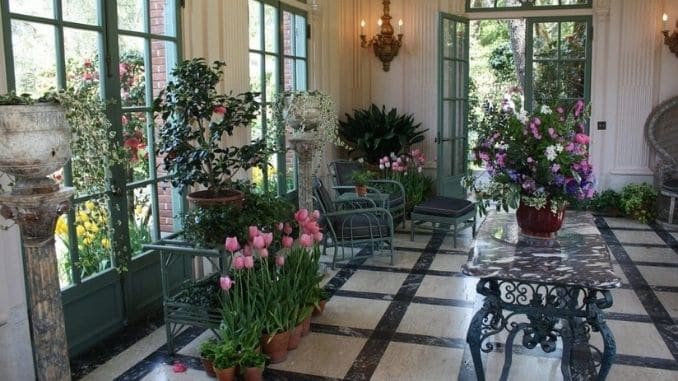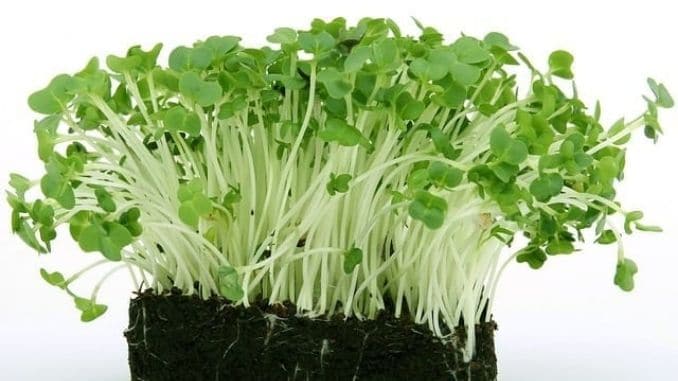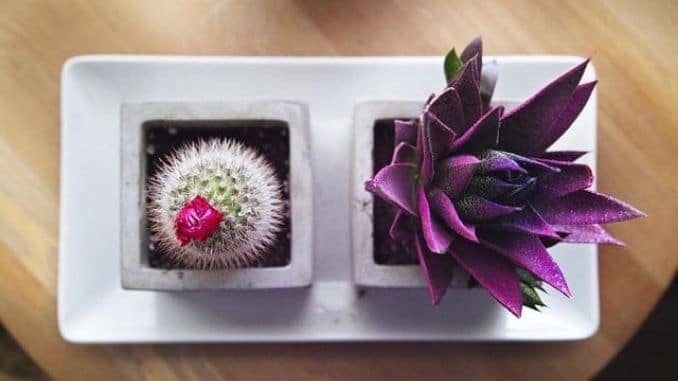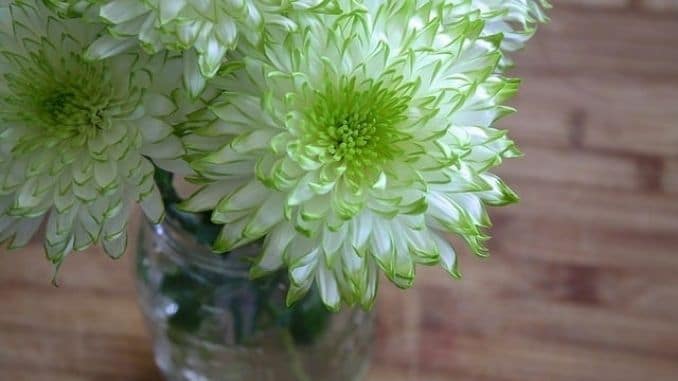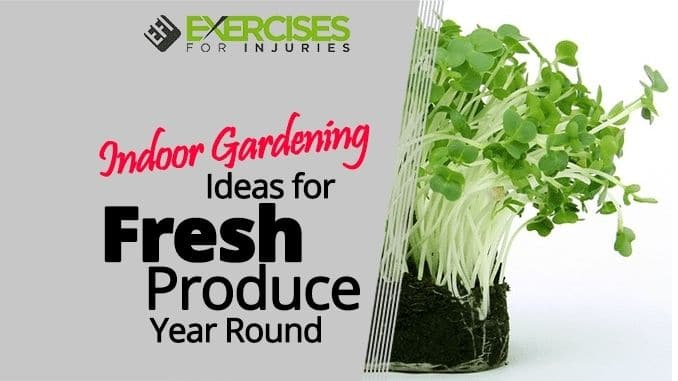
This past winter was a rough one in a lot of areas of North America, with impressive snowstorms, power outages and frigid cold temperatures. As the winter season finally loses its grip and spring thaws the land, you may be feeling a bit of spring fever and longing to get your hands in the dirt.
Gardening is an enjoyable, healthy activity ― one that benefits everyone, even if you don’t have a green thumb. However, many of us feel like we can’t get started as early as we’d like because of the unpredictable weather. Spring is officially here, but we all know how a quick weekend cold front can kill off those little sprouts we worked so hard to plant. To avoid that disappointment, we tend to wait until we’re sure the warm weather is here to stay.
There is a way to get a head start on creating your own fresh produce without subjecting your efforts to the whims of Mother Nature. You can indulge your gardening bug pretty much at any time of year if you bring your efforts inside.
How Gardening Can Help You Feel Better
Indoor Gardening Ideas: No matter what kind of gardening you do, your mind and body will thank you. Studies have shown that it helps ease stress, calm nerves and improve mood. It’s so effective that psychiatrists now use gardening in a treatment called “horticultural therapy” to help people cope with anxiety and depression.
The American Horticultural Therapy Association (AHTA) notes that research has reported connections between gardening and improved concentration, memory and attention as well as increased self-esteem, mood and well-being.
Mitchell Hewson, Canada’s first registered Horticultural Therapist, told USA Today that horticultural therapy has become increasingly popular: “Horticultural therapy stimulates thought, exercises the body and encourages an awareness of the external environment. Moreover, the clients who have benefited from this type of therapy report a renewed desire to live, decreased anxiety and improved self-worth.”
Other recent studies have connected gardening with real physical benefits. In 2007, researchers reported that “friendly” bacteria normally found in soil altered behavior in a way similar to that of antidepressants. The bacteria activated a group of neurons in the brain that produces more of the “feel-good” neurotransmitter ― serotonin.
“These studies help us understand how the body communicates with the brain and why a healthy immune system is important for maintaining mental health,” said lead author Dr. Chris Lowry. “They also leave us wondering if we shouldn’t all be spending more time playing in the dirt.”
If you’re feeling a bit fatigued after the long winter, gardening can also help boost your energy. Several studies have indicated that spending time around greenery not only improved people’s state of mind but helped them feel more active and alive. This, in turn, resulted in them approaching other activities in their lives, like work and recreation, with more energy and vigor.
Plants Provide a Healthier Home Environment
Indoor Gardening Ideas: Having plants inside your home can help make your indoor environment healthier than it would be without plants. Greenery provides a calming influence and improves mood and concentration. When flowers bloom, they create a type of aesthetic beauty that is soothing to people, lowering stress and anxiety.
Plants can also help improve the air quality in your home. The Environmental Protection Agency (EPA) states that indoor air pollution is worse than outdoor: “In the last several years, a growing body of scientific evidence has indicated that the air within homes and other buildings can be more seriously polluted than the outdoor air in even the largest and most industrialized cities. Other research indicates that people spend approximately 90 percent of their time indoors. Thus, for many people, the risks to health may be greater due to exposure to air pollution indoors than outdoors.”
Fortunately, indoor plants can help. Researchers have discovered that common houseplants like the snake plant, golden pothos and spider plant helped reduce ozone levels while NASA found that indoor plants can remove key pollutants, including formaldehyde, carbon monoxide and benzene. Some greenery inside can increase humidity naturally and reduce airborne dust.
Plants May Help Improve Family Relationships
Indoor Gardening Ideas: You may find that an indoor garden also helps improve your family relationships. Several studies have indicated that people who spend more time around plants are more likely to try to help others and demonstrate a higher level of compassion than those who don’t. In a 2012 gardening study, many of the participants noted that gardening “contributed to a sense of togetherness within the family or as a place to spend quality family time building relationships.”
Texas A&M University states that being around plants can help improve relationships between people “and increase their concern and empathy toward others.” Gardening is also a wonderful activity for parents and children to do together as it provides not only a shared activity but helps kids learn about nutrition, healthy eating and the science of how plants grow.
In a 2005 study on third to fifth-grade students who participated in a one-year gardening program, results showed that gardening helped the kids improve their self-understanding, interpersonal relationship skills and ability to work in groups. Children who learn to grow their own food are also more likely to eat more fruits and vegetables and to show higher levels of knowledge about nutrition as they age.
Gardening can even help children with learning disabilities. In one 2006 study, researchers reported that it helped kids increase their nonverbal communication skills, learn how to participate in a cooperative effort and form positive relationships with adults.
Fresh Is Best for Nutrition
Indoor Gardening Ideas: Of course, there’s one more very obvious reason why indoor gardening is a good idea. Homegrown produce is more nutritious and may help prevent disease.
Harvard Health reports that growing your own food not only inspires you to eat more fruits and vegetables but also gives you control over how much and what kind of fertilizers and pesticides come in contact with your food. You control when to harvest it as well, and produce allowed to ripen in the garden — rather than on the transport truck ― contains more nutrients naturally than store-bought alternatives.
Indeed, no matter how bright the color or crisp the texture of supermarket produce items, most have traveled a good distance from their place of origin to reach your local store, which means the nutrients have had sufficient time to degrade. According to a 2000 study, tomatoes harvested green — as they usually are before being shipped to a supermarket — contained 31 percent less vitamin C than those allowed to ripen on the vine. An earlier study reported similar results with green peppers vs. vine-ripened ones.
When you pick produce off the vine at home, you get the full benefit of all the flavonoids, antioxidants, vitamins and minerals right away. A 2015 study also reported that homegrown produce, specifically tomatoes, were sweeter and richer in nutrients than produce found on the supermarket shelves. They had a higher concentration of natural sugars, antioxidants and nutritious compounds called phenols that are all important in the fight against diseases like cancer and heart disease.
Create Your Best Indoor Gardening Space
Indoor Gardening Ideas: If you’re ready to try your own indoor garden, how do you get started? First, you need to find the right place in your home to grow your plants. You can set up a table or bench or maybe you want a larger dedicated space, such as a series of shelves or an area of the floor. Choose a space where you can regularly tend to your plants but where they will enjoy a stable life without having to be moved.
Next, you want to think about light. Light is key for good growth, so a window is good, but it’s usually not enough to help your garden grow to maturity or to yield the type of results you’re probably hoping for. That means supplemental light is a good idea.
Fluorescents are usually your best bet for growing indoor vegetables. Traditional incandescents put out too much heat. Fluorescents are more cost-effective and efficient and will provide your plants with enough light without cooking them. You can find those that are specifically designed for indoor gardens or choose a fluorescent that works in the area of your home that you’ve chosen for your garden. Position the light close to the plants, but be sure to raise it as they grow.
Optimizing Indoor Vegetable Growth: Lighting, Temperature, and Humidity Control
Indoor Gardening Ideas: There are now LED “grow lights” as well that you may choose, and they are experiencing a surge of popularity with indoor-growing enthusiasts. They last a long time and create different wavelengths, which various plants respond to. Feel free to experiment.
Your lights don’t need to be on all the time, though. For most plants, 14 to 16 hours of light per day is best. You can use a timer so that your lights go off and on automatically.
Once you have your lighting set up, you want to create the right temperature for your plants. Most leafy greens prefer cooler temperatures, but peppers, tomatoes, cucumbers and beans like it a bit warmer. As a general rule, you can set the room to 65 to 75 degrees Fahrenheit. That means it’s best to avoid attics and garages as they are typically too cold.
You can also use soil heat mats to increase temperature where needed. These electric mats heat pots from the bottom, so you can use them only for those plants that need to feel cozier while leaving alone those that are more satisfied with room temperature.
Next, you need to be sure the room is humid enough to create healthy plants. If you live in a dry climate or, if the air is dry because of cooler temperatures, you can increase humidity in a few ways. Try misting the plants daily, run a humidifier in the room or place a tray of water filled with lava rocks in the room to help increase evaporation.
Choose Your Materials: Soil and Seeds
Indoor Gardening Ideas: Once you have your space set up, it’s time to supply your garden with the raw materials you’ll need. Start with the soil. It’s usually best to avoid outdoor soil as it may contain weed seeds and insects, and it’s often very heavy.
You want loose soil that will drain well, so look for an organic potting mix made for vegetable gardens. These usually contain the various types of soil mixes that are best for your plants and will also create pots that will be lighter and easier to move around when you need to.
Next, you’ll need containers for your plants. Here, you want to consider what types of plants you’ll be growing. Greens and radishes, for example, do fine in shallow containers while tomatoes and beans need larger pots. Root-growing veggies like carrots and beets will do best in deeper containers that allow for the depth of growth.
What type of fertilizer will you use? This should be your next consideration. There are many from which to choose, but you’ll need something to aid in your plants’ growth. Indoor plants need that extra boost of nutrients since those in the soil are used up quickly or leached out when watering. Read the instructions and don’t overfeed as this can damage the plant.
Now the fun part: choosing which plants you’ll grow. You can experiment to see which you enjoy. Most plants can be grown indoors successfully. Some good indoor garden options include:
- Salad greens
- Kale
- Chard
- Carrots
- Onions
- Bell peppers
- Tomatoes
- Beans
- Strawberries
- Blueberries
- Dwarf apples
- Dwarf citrus fruits like lemons and mandarin oranges
- Dwarf avocados
Herbs such as basil, parsley, oregano, cilantro, rosemary and lavender also do well in indoor gardens.
Growing and Managing Your Plants
Indoor Gardening Ideas: Watering is probably one of the most difficult facets of indoor gardening to master. It’s crucial for your plants, but there’s always the question of “how much?” Setting your pots and other containers in trays lined with small stones can help catch runoff and prevent overwatering better.
To increase successful growing, watch your plants. Signs of overwatering include:
- Mold on the soil surface
- Root rot
- Stunted growth
- Leaf drop
- Discoloration
- Eventual plant death
Signs of underwatering include:
- Dry soil
- Brown edges on the leaves or yellow leaves
- Wilting foliage, usually along the outer tips of the leaves
- Roots showing at the surface
- Eventual plant death
Next, you’ll want to watch out for pests. Indoor gardening usually results in fewer pests than outdoor gardening — it’s one of the benefits. Sometimes, however, bugs can still invade your well-cared-for containers. Usually, an organic insecticidal soap will work to get rid of common indoor insects like mealy bugs, mites, aphids or whiteflies. Use caution to follow the directions and not overuse.
Some Other Creative Indoor Gardening Ideas
The more you grow your plants and experiment with containers, lighting, watering, temperature, fertilizer and various seed combinations, the more experience you’ll gain. Eventually, you may want to branch out.
Fortunately, there are many creative ideas you can use in your indoor garden. Here are a few to get you started:
- Mason Jar Gardening
This is a popular creative idea that allows you to grow herbs easily indoors. Plant them in Mason jars, using stones in the bottom to help catch water overflow. Then, attach the jars to wooden planks on your walls to make the most of your space. Circular plastic or flexible metal clamps work well for attachments.
- Plastic Bottle Gardening
This idea is similar to Mason jar gardening, but you use plastic bottles instead, such as those used for soda or water. Turn them on their sides, cut a square hole in the top and plant your seeds. These can then be hung with string on the wall.
-
Teacup Planters
If you want your garden to look a little fancy, you can use old teacups and saucers or vintage teapots for your planting containers.
-
Vertical Gardening
There are many creative ideas out there for building a vertical garden, to help you conserve space. You can make your own garden wall by using wooden 2x4s for the sides and top, setting them into a firm base and stretching chicken wire across the space in between. Also, you can then hang your pots in rows on the chicken wire with hooks. You can do the same thing with a steel mesh that you attach to the wall, with a wooden pallet attached to the wall or with a wooden trellis.
-
Shelf Gardening
Following the same principle as that of vertical gardening, you can build shelves into the walls and place your plants on them to maximize space.
-
Hanging Garden
If you have hanging pots, you can attach them to just about anything in your gardening area. Even a garment rack will work or a shower rod suspended between two points.
The options are endless when it comes to creating your indoor garden. The most important thing is to experiment, be patient with yourself and have fun. Happy growing!
If you are looking for ways on how to bring back your natural vitality while relieving chronic inflammation and boosting up the natural fat-burning hormones of your body, then click here to check out the Best Foods that Rapidly Slim & Heal In 7 Days program!

